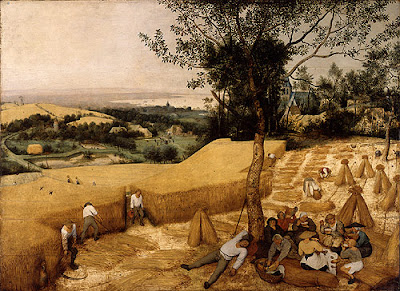Your assignment this week is to paint an evergreen, using one of the great masters as your muse.
 |
|
Herdsmaid, 1908, Anders Zorn. You could identify the species of trees in this painting, but it’s short on detail.
|
Last week, I wrotethat there are as many ways to paint water as there are moments in the day. The same is true of painting evergreens.
We can look to the painters of the great northern landscapes for guidance on evergreens. Swedes Bruno Liljefors and Anders Zorn, Tom Thomson and the Group of Seven, the Russian Peredvizhniki, and the northeastern painters from Winslow Homer to Andrew Wyeth are all worth studying.
 |
|
Winter landscape at dawn, 1900, Bruno Liljefors. If the evergreens are in a supporting role, they’re often painted as a single mass.
|
Spend an hour searching their work on the internet along with the key words “spruce,” “pine”, or “evergreen.” You’ll notice that most of these artists handled the subject differently depending on whether they were in the studio or painting en plein air, or if the trees were the main subject or incidental.
 |
|
After the bath, 1895, Anders Zorn, courtesy Nationalmuseum. The evergreens are nothing more than a few brushstrokes, but they’re perfectly realized.
|
Anders Zorn often used evergreens behind his pulchritudinous nudes. The contrast between his perfectly-observed trees and cookie-cutter models is striking. The Herdsmaid (1908) is probably the best evergreen painting ever executed. It’s all about the young trees, but Zorn never overstates the detail. Instead, he allows his brush to wash softly over the darker background, suggesting the softness of pine needles.
That apparent artlessness rests on a solid ground of observation. Zorn (and Wyeth) were able to be specific but loose because they drew and observed endlessly from nature. Each species of tree has a specific design. There are no shortcuts to knowing and understanding them. If you want to be able to paint trees, you must first draw them—a lot. Observe their branching structure, their needles or leaves, their bark, and where they like to grow.
 |
|
Spruce Gun, watercolor, 1973, Andrew Wyeth, private collection
|
But trees are also forgiving; when you understand their structure, you can fearlessly mess with their form. While Wyeth’s tree in Spruce Gun looks perfectly natural to us, it’s also stylized to give a dynamic boost to the gun.
Either watercolor or oil are perfect for the organic character of trees; they can be schooled into great detail or allowed to wash with great softness across the canvas or paper.
It’s easy to become overwhelmed with detail in a tree, but it’s best, instead, to concentrate on overall values and colors instead. Start with the large shapes and concentrate on a few details at the end. After all, when we notice trees at all, we generally perceive them as masses, rather than as individual details. The exception is when someone is interacting with the tree, as in Mary Cassatt’s Child Picking a Fruit.
 |
|
Isles of Spruce, silkscreen, c. 1943, Arthur Lismer. While the contrast between background and foreground is high, the values within individual trees are quite close.
|
How do we create form in trees? The same way we do with any other subject, by creating a pattern of light and dark. Our first question ought always be, “where is the light coming from?” The second question should be, “Is the light cool or warm?”
Start with a drawing. This is where you can get carried away with the gothic intricacies of the structure, and get them out of your system. Make sure that the height and width relationship is accurate. Also double-check that you have branches on all sides of the trunk, not just to the sides. Some will come directly towards you. While these are difficult to draw, they’re what anchor the tree in space.
 |
|
Dusk, 1900, Isaac Levitan, courtesy State Tretyakov Gallery. Depending on the light, evergreens may be represented with no green at all.
|
I’ve written before about working with a green matrix; you can use it as successfully with evergreens as with deciduous trees. Let’s assume you’re drawing in early morning and the light is golden. Make the shadows cooler and darker and the highlights warm and light. It’s possible that the only true greens in your tree will be in the midtones or highlights. But avoid excessive value jumps; making the highlights too light can end in visual chaos. It’s usually what’s happened when someone complains that they’ve gotten lost in the detail.
 |
|
Montreal River, c. 1920, Lawren S. Harris, courtesy McMichael Canadian Art Collection. The Group of Seven painters were interested in trees as screens.
|
Unless you’re painting a deciduous tree in the dead of winter, the branches and trunk are secondary to the masses of foliage.
Your assignment this week is to paint an evergreen, either from life or a photograph. Before you start, find a masterpiece from one of the artists I’ve mentioned above, and study his paint application carefully. Try to emulate that in your painting.






.jpg)


